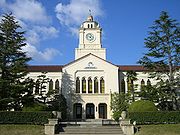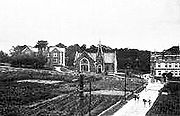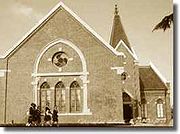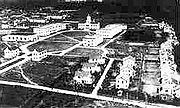
Kwansei Gakuin University
Encyclopedia
, colloquially abbreviated to , is a non-denominational Christian
private
and coeducational university
located in Nishinomiya
, Sanda
, Osaka City, and Tokyo, Japan
.
Chartered in 1932, it is the 13th institution with university status in Kansai region, the 23rd-oldest outside of Greater Tokyo, and the 46th-oldest in the country.
Kwansei Gakuin University is one of the four leading private universities in the Kansai region of Japan (other three are Doshisha University
, Ritsumeikan University
, and Kansai University
). It should not be confused with , an entirely separate university in Suita, Osaka
.



 Founded by the Revd Walter Russell Lambuth
Founded by the Revd Walter Russell Lambuth
in 1889, Kwansei Gakuin was originally a day school
/ seminary
affiliated with the Methodist Episcopal Church, South
(MEC-S) in the Foreigners' Settlement (Concession
) in Kobe. KG steadily expanded as a middle school
, rather than a seminary through 1900s.
Then its expansion accelerated as an institution of higher education, especially after Kwansei Gakuin was under the joint control of MEC-S and the Canadian Methodist Church
in 1911. The school then transferred to finally its present Nishinomiya-Uegahara campus near Mount Kabuto in 1929. The school, formerly all-male, opened its doors to women on equal terms with men in 1943.
subordinates. The university and United Nations Volunteers
(UNV) reached an agreement establishing the university as the first institution of higher education in Asia
to form a volunteer-sending partnership with the United Nations Information Technology Service (UNITeS) in 2003.
KGU and the United Nations High Commissioner for Refugees
(UNHCR) Representation in Japan concluded an agreement to establish a special university scholarship system for refugees in Japan in May 2006. Under this agreement, Kwansei Gakuin started the UNHCR-KGU Higher Education Program for Refugees in Japan in April 2007, and two refugees are currently enrolled.
| valign="top" |
|}
Kwansei Gakuin University is a member of , which was restructured in 1982. The school was recognized as one of for about three decades until KG was often excluded from the League, then Kansai Region's premium collegiate baseball league, in 1970s.
KG is currently best known for its American football
team, as known as Fighters, dominating the Division I League of Kansai Collegiate American Football Association
with a total of 46 league titles, 22 national collegiate titles, and one national title from 1948–2005 seasons. Kwansei Gakuin, Kyoto
and Ritsumeikan
have battled for American football dominance in the league for the last fifteen years.
The school's traditional athletic rivalry with Kansai University
is intense again in every sport since the two institutions started , which is less known than Keio
–Waseda
rivalry in the country's college athletics, in 1978. Kwansei Gakuin ties the series, 14–14 for the past three years running.
Kwansei Gakuin has several athletic facilities including the 3rd Field (for), one of the first American football fields in the country, the Soccer Field, and the General Gymnasium.
KG athletics are supported by the Traditional Cheerleading Team, the Brass Band, and the Cheerleading Team of Kwansei Gakuin University Cheerleading Division. The division's three teams attend every American football game throughout the fall, as well as most baseball games throughout the spring. The school's unofficial mascot was used to be "Kwangaku eitoman", the popular cartoon/animation character 8th Man in 1960s. Kwansei Gakuin has several fight song
s, the most played of which, especially at American football games, are "Shingetsu-ki no moto ni", "Fight on Kwansei", and "I'm Popeye the Sailor Man".
In addition to KG's varsity athletics, a wide variety of clubs and intramural sports teams have been organized as student organizations under the auspices of the Division of Students. Most of the club and intramural sports are coed.
The name was romanized according to the vogue pronunciation among progressive students in the late 19th century. The "official" pronunciation of kwan can be heard in performances of the school song, but the modern pronunciation of kan is usual in other contexts. Thus, the abbreviated name Kwangaku is usually pronounced as kangaku, though Kwangaku would be correct in theory.
Christian
A Christian is a person who adheres to Christianity, an Abrahamic, monotheistic religion based on the life and teachings of Jesus of Nazareth as recorded in the Canonical gospels and the letters of the New Testament...
private
Private school
Private schools, also known as independent schools or nonstate schools, are not administered by local, state or national governments; thus, they retain the right to select their students and are funded in whole or in part by charging their students' tuition, rather than relying on mandatory...
and coeducational university
University
A university is an institution of higher education and research, which grants academic degrees in a variety of subjects. A university is an organisation that provides both undergraduate education and postgraduate education...
located in Nishinomiya
Nishinomiya, Hyogo
is a city located in Hyōgo, Japan, between the cities of Ōsaka and Kōbe. On April 1, 2005, the city of Nishinomiya celebrated its 80th anniversary. It is best known as the home of Kōshien Stadium, where the Hanshin Tigers baseball team plays home games and where Japan's annual high school baseball...
, Sanda
Sanda, Hyogo
is a city located in Hyōgo, Japan.As of 2008, the city has an estimated population of 113,585 and the density of 540 persons per km². The total area is 210.22 km².The city was founded on July 1, 1958.-History:...
, Osaka City, and Tokyo, Japan
Japan
Japan is an island nation in East Asia. Located in the Pacific Ocean, it lies to the east of the Sea of Japan, China, North Korea, South Korea and Russia, stretching from the Sea of Okhotsk in the north to the East China Sea and Taiwan in the south...
.
Chartered in 1932, it is the 13th institution with university status in Kansai region, the 23rd-oldest outside of Greater Tokyo, and the 46th-oldest in the country.
Kwansei Gakuin University is one of the four leading private universities in the Kansai region of Japan (other three are Doshisha University
Doshisha University
, or is a prestigious private university in Kyoto, Japan. The university has approximately 27,000 students on three campuses, in faculties of theology, letters, law, commerce, economics, policy, and engineering...
, Ritsumeikan University
Ritsumeikan University
Ritsumeikan University has a growing reputation as one of the main private universities of Japan. It is part of a group of prestigious private universities in the Kansai area, called "Kan -Kan -Dou -Ritsu "...
, and Kansai University
Kansai University
, or , is a private non-sectarian and coeducational university located in Suita, Osaka, Japan and in two other locations: Osaka City; and Takatsuki, Osaka.-History:Kansai University was founded as Kansai Law School in November 1886, in Osaka...
). It should not be confused with , an entirely separate university in Suita, Osaka
Suita, Osaka
is a city located in northern Osaka, Japan. As of August 1, 2011, the city has an estimated population of 356,751 and the density of 9,880 persons per km². The total area is 36.11 km²....
.
Overview




Walter Russell Lambuth
Walter Russell Lambuth was a Chinese-born American Methodist Bishop who worked as a missionary establishing schools and hospitals in China, Korea and Japan in the 1880s.-Birth and Family:...
in 1889, Kwansei Gakuin was originally a day school
Day school
A day school—as opposed to a boarding school—is an institution where children are given educational instruction during the day and after which children/teens return to their homes...
/ seminary
Seminary
A seminary, theological college, or divinity school is an institution of secondary or post-secondary education for educating students in theology, generally to prepare them for ordination as clergy or for other ministry...
affiliated with the Methodist Episcopal Church, South
Methodist Episcopal Church, South
The Methodist Episcopal Church, South, or Methodist Episcopal Church South, was the so-called "Southern Methodist Church" resulting from the split over the issue of slavery in the Methodist Episcopal Church which had been brewing over several years until it came out into the open at a conference...
(MEC-S) in the Foreigners' Settlement (Concession
Concession (territory)
In international law, a concession is a territory within a country that is administered by an entity other than the state which holds sovereignty over it. This is usually a colonizing power, or at least mandated by one, as in the case of colonial chartered companies.Usually, it is conceded, that...
) in Kobe. KG steadily expanded as a middle school
Middle school
Middle School and Junior High School are levels of schooling between elementary and high schools. Most school systems use one term or the other, not both. The terms are not interchangeable...
, rather than a seminary through 1900s.
Then its expansion accelerated as an institution of higher education, especially after Kwansei Gakuin was under the joint control of MEC-S and the Canadian Methodist Church
United Church of Canada
The United Church of Canada is a Protestant Christian denomination in Canada. It is the largest Protestant church and, after the Roman Catholic Church, the second-largest Christian church in Canada...
in 1911. The school then transferred to finally its present Nishinomiya-Uegahara campus near Mount Kabuto in 1929. The school, formerly all-male, opened its doors to women on equal terms with men in 1943.
International relations
Kwansei Gakuin University has several agreements with the United NationsUnited Nations
The United Nations is an international organization whose stated aims are facilitating cooperation in international law, international security, economic development, social progress, human rights, and achievement of world peace...
subordinates. The university and United Nations Volunteers
United Nations Volunteers
The United Nations Volunteers program is a United Nations organization that advocates the role and benefits of volunteerism for development, integrates volunteers into development programmes, and mobilises volunteers for development projects. It was created to be a development partner for UN...
(UNV) reached an agreement establishing the university as the first institution of higher education in Asia
Asia
Asia is the world's largest and most populous continent, located primarily in the eastern and northern hemispheres. It covers 8.7% of the Earth's total surface area and with approximately 3.879 billion people, it hosts 60% of the world's current human population...
to form a volunteer-sending partnership with the United Nations Information Technology Service (UNITeS) in 2003.
KGU and the United Nations High Commissioner for Refugees
United Nations High Commissioner for Refugees
The Office of the United Nations High Commissioner for Refugees , also known as The UN Refugee Agency is a United Nations agency mandated to protect and support refugees at the request of a government or the UN itself and assists in their voluntary repatriation, local integration or resettlement to...
(UNHCR) Representation in Japan concluded an agreement to establish a special university scholarship system for refugees in Japan in May 2006. Under this agreement, Kwansei Gakuin started the UNHCR-KGU Higher Education Program for Refugees in Japan in April 2007, and two refugees are currently enrolled.
Campus
Since 1929, the flagship campus of Kwansei Gakuin University is located in Nishinomiya, Hyōgo, with two smaller campuses in Sanda, Hyōgo and downtown Osaka City (Umeda).- Nishinomiya-Uegahara Campus (1929–present)
- Kobe-Sanda Campus (1995–present)
- Osaka-Umeda Campus (2004–present)
- Tokyo-Marunouchi Campus (2007–present)
Undergraduate units
- School of Theology (1952)
- School of Humanities (1934)
- School of Sociology (1960)
- School of Law and Politics (1948)
- School of Economics (1934)
- School of Business Administration (1951)
- School of Science and Technology (1961, Kobe-Sanda Campus)
- School of Policy Studies (1995, Kobe-Sanda)
- School of Human Welfare Studies (2008)
- School of Education (2009)
- School of International Studies (2010)
Graduate schools
- Graduate School of Theology (1952)
- Graduate School of Humanities (1950)
- Graduate School of Sociology (1961)
- Graduate School of Law and Politics (1950)
- Graduate School of Economics (1950)
- Graduate School of Business Administration (1953)
- Graduate School of Science and Technology (1965, Kobe-Sanda)
- Graduate School of Policy Studies (2001, Kobe-Sanda)
- Graduate School of Language, Communication, and Culture (2001)
- Graduate School of Human Welfare Studies (2010)
- School of Education (2009)
Professional schools (KGPS)
- Law School (2004)
- Institute of Business and AccountingInstitute of Business and AccountingKwansei Gakuin Institute of Business and Accounting is one of the professional schools of Kwansei Gakuin University, and one of the Japan's leading management schools....
http://www.kwansei-ac.jp/iba/ (2005, Osaka-Umeda)
Credit courses
Non-credit courses
| valign="top" |
Centers and institutes
- Division of Research Development and Outreach (ja)
- Institute for Industrial Research
- Institute for Integrated Communication Research and Development
- Center for Information and Media Studies
- Language Center
- Research Center for Teacher Development
- Institute for Sports and Health Sciences
- Institute for Human Rights Research and Education
- Research Center for Christianity and Culture
- High-Tech Research Center
- Center for International Education and Cooperation
- Japan and East Asia Studies ProgramJapan and East Asia Studies ProgramJapan and East Asia Studies Program is an inter-departmental academic program of Japan and East Asia Studies for international students at Kwansei Gakuin University in Nishinomiya, Japan...
http://www.kwansei.ac.jp/ContentsEn?cnid=3706&mode=3 (1979) - East Asia Student Encounter (EASE)
- Canadian Studies Seminar (1990)
- International Student Program(Oxford University Joint Seminer) (1999)
- Japan and East Asia Studies Program
- Institute for Research on Disaster Reconstruction System (ja)
- Research Centers for Specific Projects (ja)
- Research Center for Thanatology & Spirituality
- Research Center for Urban Innovation
- Research Center for Musical and Revue
- Research Center for Economies with Low Fertility
- Research Center for Friendly Polymers
- Research Center for Human Media
- Research Center for Universal Design in Education
- Research Center for Entertainment Computing
- Research Center for International Human Development
- Research Center for Policy Studies on Region, Community and Environment
- Christian Center
- Sengari CampSengari Campis an off-campus, public facility located outside of Sanda, Hyōgo, Japan that is operated by Kwansei Gakuin University. About 12,000 people visit Sengari Camp a year. Half of them are connected to Kwansei Gakuin University, for example, kindergarten children, junior high school, high school, and...
- Archives
- Health Care Center
University libraries
University press
|}
Faculty and students
Kwansei Gakuin University hosts more than 300 international students from a variety of nations.Athletics
Kwansei Gakuin has one of the most diverse varsity athletic programs in Japan, and its 34 varsity teams that compete in regional collegiate leagues. Although the school, unlike other private universities in the country, does not offer specific scholarships for student-athletes, it is still competitive with the top echelon of Japanese collegiate teams in the sports of American football, basketball, lacrosse and soccer.Kwansei Gakuin University is a member of , which was restructured in 1982. The school was recognized as one of for about three decades until KG was often excluded from the League, then Kansai Region's premium collegiate baseball league, in 1970s.
KG is currently best known for its American football
American football
American football is a sport played between two teams of eleven with the objective of scoring points by advancing the ball into the opposing team's end zone. Known in the United States simply as football, it may also be referred to informally as gridiron football. The ball can be advanced by...
team, as known as Fighters, dominating the Division I League of Kansai Collegiate American Football Association
College rivalry
Pairs of schools, colleges and universities, especially when they are close to each other either geographically or in their areas of specialization, often establish a college rivalry with each other over the years. This rivalry can extend to both academics and athletics, the latter being typically...
with a total of 46 league titles, 22 national collegiate titles, and one national title from 1948–2005 seasons. Kwansei Gakuin, Kyoto
Kyoto University
, or is a national university located in Kyoto, Japan. It is the second oldest Japanese university, and formerly one of Japan's Imperial Universities.- History :...
and Ritsumeikan
Ritsumeikan University
Ritsumeikan University has a growing reputation as one of the main private universities of Japan. It is part of a group of prestigious private universities in the Kansai area, called "Kan -Kan -Dou -Ritsu "...
have battled for American football dominance in the league for the last fifteen years.
The school's traditional athletic rivalry with Kansai University
Kansai University
, or , is a private non-sectarian and coeducational university located in Suita, Osaka, Japan and in two other locations: Osaka City; and Takatsuki, Osaka.-History:Kansai University was founded as Kansai Law School in November 1886, in Osaka...
is intense again in every sport since the two institutions started , which is less known than Keio
Keio University
,abbreviated as Keio or Keidai , is a Japanese university located in Minato, Tokyo. It is known as the oldest institute of higher education in Japan. Founder Fukuzawa Yukichi originally established it as a school for Western studies in 1858 in Edo . It has eleven campuses in Tokyo and Kanagawa...
–Waseda
Waseda University
, abbreviated as , is one of the most prestigious private universities in Japan and Asia. Its main campuses are located in the northern part of Shinjuku, Tokyo. Founded in 1882 as Tokyo Senmon Gakko, the institution was renamed "Waseda University" in 1902. It is known for its liberal climate...
rivalry in the country's college athletics, in 1978. Kwansei Gakuin ties the series, 14–14 for the past three years running.
Kwansei Gakuin has several athletic facilities including the 3rd Field (for), one of the first American football fields in the country, the Soccer Field, and the General Gymnasium.
KG athletics are supported by the Traditional Cheerleading Team, the Brass Band, and the Cheerleading Team of Kwansei Gakuin University Cheerleading Division. The division's three teams attend every American football game throughout the fall, as well as most baseball games throughout the spring. The school's unofficial mascot was used to be "Kwangaku eitoman", the popular cartoon/animation character 8th Man in 1960s. Kwansei Gakuin has several fight song
Fight song
A fight song is primarily an American and Canadian sports term, referring to a song associated with a team. In both professional and amateur sports, fight songs are a popular way for fans to cheer for their team...
s, the most played of which, especially at American football games, are "Shingetsu-ki no moto ni", "Fight on Kwansei", and "I'm Popeye the Sailor Man".
In addition to KG's varsity athletics, a wide variety of clubs and intramural sports teams have been organized as student organizations under the auspices of the Division of Students. Most of the club and intramural sports are coed.
School name
The name came from its founder Walter Russell Lambuth's desire to serve citizens of , the western part of Japan, while the word was translated from "college" at that time. Thus, Kwansei gakuin means West Japan College literally.The name was romanized according to the vogue pronunciation among progressive students in the late 19th century. The "official" pronunciation of kwan can be heard in performances of the school song, but the modern pronunciation of kan is usual in other contexts. Thus, the abbreviated name Kwangaku is usually pronounced as kangaku, though Kwangaku would be correct in theory.

